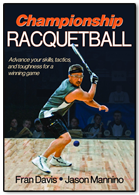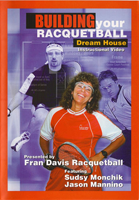 As simple as it may seem, keeping your opponent back and out of the middle of the court is effective because 30 percent of all balls can be killed from the dotted line, so the odds undoubtedly go down the farther back one hits. Controlling your opponent’s court position keeps them as far away from the front wall, the target, as possible. You can implement the strategy of controlling your opponent’s court position, whichever level you play. Here’s how:
As simple as it may seem, keeping your opponent back and out of the middle of the court is effective because 30 percent of all balls can be killed from the dotted line, so the odds undoubtedly go down the farther back one hits. Controlling your opponent’s court position keeps them as far away from the front wall, the target, as possible. You can implement the strategy of controlling your opponent’s court position, whichever level you play. Here’s how:
Hit offensive passing shots (the fundamental down-the-line and cross-court or the more advanced overhead, sidearm and wide-angle) or by going defensive with ceiling balls (fundamental) or z-shots (advanced). Use the techniques in my book, “Championship Racquetball” to understand the strategy,“Keep Your Opponent Deep in the Court” (Chapter 7, page 194).
Keeping your opponent deep in the court is a strategy I use with my “Championship Team,” Rocky, Paola, Jason, Taylor, Sharon, Connor, Jordan, and Wayne, who all recognize its importance. I encourage each and every one of them to use this strategy, as they know it puts their opponent in a position as far from the front wall as possible, forcing more mistakes from their opponents. Pros like Jason Mannino used this strategy against Sudsy Monchik, Cliff Swain, and John Ellis. It worked brilliantly. Today, Rocky Carson uses this same strategy against Kane Waselenchuk, Alvaro Beltran, Jose Rojas, and Ben Croft. It still works beautifully.
Let’s examine what tools Rocky, Paola, Jason and all of my athletes use for what I call “Keeping their Opponents Deep” by taking a closer look at all 3 sides of The Sports Racquetball Triangle: Conditioning, Mental, and Physical Skills
Left Side of the Triangle
Stretching involves positioning your muscles in a way that encourages them to recruit more fibers by warming the muscle. Properly warmed muscles, therefore, have the enhanced range of motion that is critical for racquetball’s stops, starts, turns and changes of direction. A stretching workout enhances circulation, blood flow, and oxygen to certain areas of your body and therefore increases your metabolism in that body part. Stretching workouts also raise your body’s core temperature and warms up your muscles, tendons, and ligaments leading to fewer pulled muscles and injuries.
Use the stretching exercises in my book, “ Championship Racquetball” to understand your conditioning level, which will lead to rallying longer and putting, but “Keeping Your Opponent Deep in the Court.” (Chapter 10, pages 252-255).
You want to make sure you are routinely eating right and drinking lots of water as your body and mind NEEDS this in order to think clearly and focus on the strategy that can win you more matches by “Keeping Your Opponent Deep.”
***Check my book, “Championship Racquetball” for specific information on your NUTRITIONAL needs.
Right Side of the Triangle
Mental Skills
The number one technique in maintaining mental toughness is visualization, the art of creating images in your mind of perfect technique and performance while allowing the images to become imprinted into your muscle memory, which lives in your gut. The best athletes visualize naturally without even reallizing it. Every athlete needs to understand that this is the key to perfecting consistent performance. It’s true that what your mind can perceive and your body can believe, you can achieve!
Use the mental skills in my book, “ Championship Racquetball” to understand that visualizing “keeping your opponent deep in the court”, which will help you to practice that in your mind so you then do it on the court (Chapter 9, pages 218-220).
Base of the Triangle
Physical Skills
Practice the shots that will “keep your opponent deep in the court:”
– The fundamental offensive passing shots – down the line and cross-court passes
– The advanced offensive passing shots – the overhead, sidearm and wide-angle passes
– The fundamental defensive shot- ceiling ball
– The advanced defensive shot – z shot
Make sure, as I have recommended in the past, to track your progress by choosing the shot and practicing, keeping track of those you make to the total. As you practice more of them, your ratio of winners will improve and you’ll get more consistent at “keeping your opponent deep.”
ALL of the players I coach, from the professionals led by Rocky and Paola to the amateurs, know just how important it is to “Keep your Opponent Deep in the Court.” By keeping your opponent deep that will probably win you more points, more games and thusly more matches because more mistakes happen from 35 feet then from 25 feet. My top pros’ records speak for themselves.
In the next issue, I will continue to build your Championship Racquetball Game one level at a time so you too can be ready to become the champion you always dreamed of becoming, by giving you the tools to make it a reality. Rocky’s and all my athletes’ “Championship Racquetball Games” stem from their focus on ALL 3 sides of the triangle working together so they can develop into top competitors. Without a shadow of a doubt, they KNOW just how important it is to do the work. They are living proof it works and their titles substantiate it.
For details on more personalized instruction, a weekend camp, instructional DVD’s, our book, Championship Racquetball, and our APP (coming soon), ALL which covers all aspects of the Sports Racquetball Triangle and more, please visit www.FranDavisRacquetball.com.Fran Davis is a 2004 racquetball Hall of Fame inductee, Racquetball Woman of the Year 2009, Coach #2 IRT Pro Player and 1X US Open Champion, Rocky Carson; Coach #1 Women’s LPRT Pro Player and 4X and present US Open Champion, Paola Longoria; Coach Jr. World & National Champion, Intercollegiate Champion, & IRT Pro Player, Taylor Knoth; Coach Intercollegiate Champion & LPRT Pro Player, Sharon Jackson; Master Professional Instructor/Coach USAR-IP. International Racquetball Tour.










